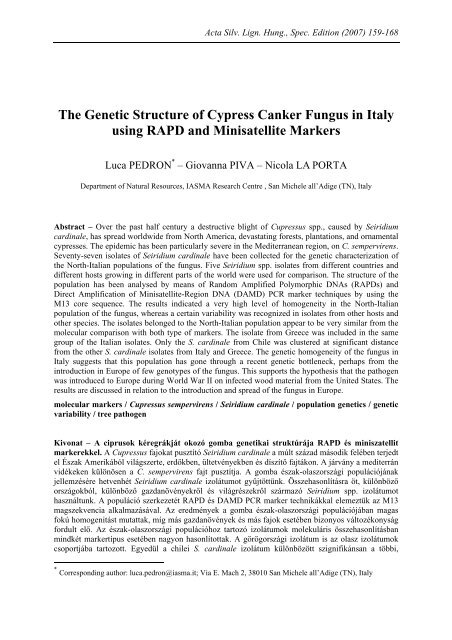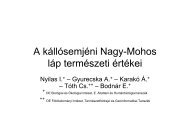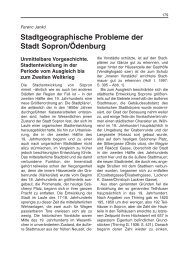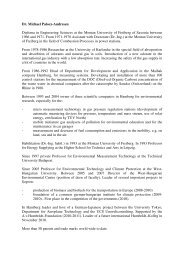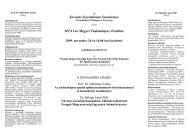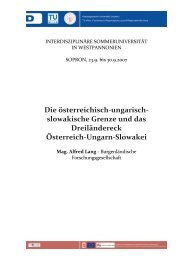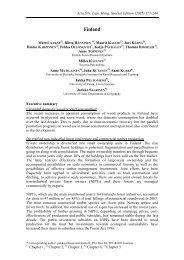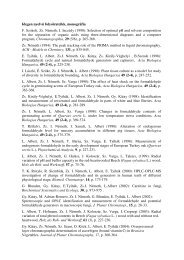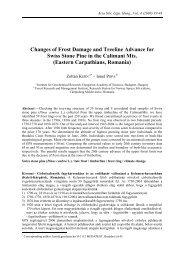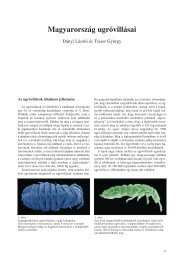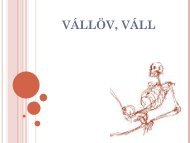PEDRON, Luca - PIVA, Giovanna - LA PORTA, Nicola
PEDRON, Luca - PIVA, Giovanna - LA PORTA, Nicola
PEDRON, Luca - PIVA, Giovanna - LA PORTA, Nicola
You also want an ePaper? Increase the reach of your titles
YUMPU automatically turns print PDFs into web optimized ePapers that Google loves.
Acta Silv. Lign. Hung., Spec. Edition (2007) 159-168<br />
The Genetic Structure of Cypress Canker Fungus in Italy<br />
using RAPD and Minisatellite Markers<br />
<strong>Luca</strong> <strong>PEDRON</strong> * – <strong>Giovanna</strong> <strong>PIVA</strong> – <strong>Nicola</strong> <strong>LA</strong> <strong>PORTA</strong><br />
Department of Natural Resources, IASMA Research Centre , San Michele all’Adige (TN), Italy<br />
Abstract – Over the past half century a destructive blight of Cupressus spp., caused by Seiridium<br />
cardinale, has spread worldwide from North America, devastating forests, plantations, and ornamental<br />
cypresses. The epidemic has been particularly severe in the Mediterranean region, on C. sempervirens.<br />
Seventy-seven isolates of Seiridium cardinale have been collected for the genetic characterization of<br />
the North-Italian populations of the fungus. Five Seiridium spp. isolates from different countries and<br />
different hosts growing in different parts of the world were used for comparison. The structure of the<br />
population has been analysed by means of Random Amplified Polymorphic DNAs (RAPDs) and<br />
Direct Amplification of Minisatellite-Region DNA (DAMD) PCR marker techniques by using the<br />
M13 core sequence. The results indicated a very high level of homogeneity in the North-Italian<br />
population of the fungus, whereas a certain variability was recognized in isolates from other hosts and<br />
other species. The isolates belonged to the North-Italian population appear to be very similar from the<br />
molecular comparison with both type of markers. The isolate from Greece was included in the same<br />
group of the Italian isolates. Only the S. cardinale from Chile was clustered at significant distance<br />
from the other S. cardinale isolates from Italy and Greece. The genetic homogeneity of the fungus in<br />
Italy suggests that this population has gone through a recent genetic bottleneck, perhaps from the<br />
introduction in Europe of few genotypes of the fungus. This supports the hypothesis that the pathogen<br />
was introduced to Europe during World War II on infected wood material from the United States. The<br />
results are discussed in relation to the introduction and spread of the fungus in Europe.<br />
molecular markers / Cupressus sempervirens / Seiridium cardinale / population genetics / genetic<br />
variability / tree pathogen<br />
Kivonat – A ciprusok kéregrákját okozó gomba genetikai struktúrája RAPD és miniszatellit<br />
markerekkel. A Cupressus fajokat pusztító Seiridium cardinale a múlt század második felében terjedt<br />
el Észak Amerikából világszerte, erdőkben, ültetvényekben és díszítő fajtákon. A járvány a mediterrán<br />
vidékeken különösen a C. sempervirens fajt pusztítja. A gomba észak-olaszországi populációjának<br />
jellemzésére hetvenhét Seiridium cardinale izolátumot gyűjtöttünk. Összehasonlításra öt, különböző<br />
országokból, különböző gazdanövényekről és világrészekről származó Seiridium spp. izolátumot<br />
használtunk. A populáció szerkezetét RAPD és DAMD PCR marker technikákkal elemeztük az M13<br />
magszekvencia alkalmazásával. Az eredmények a gomba észak-olaszországi populációjában magas<br />
fokú homogenitást mutattak, míg más gazdanövények és más fajok esetében bizonyos változékonyság<br />
fordult elő. Az észak-olaszországi populációhoz tartozó izolátumok molekuláris összehasonlításban<br />
mindkét markertípus esetében nagyon hasonlítottak. A görögországi izolátum is az olasz izolátumok<br />
csoportjába tartozott. Egyedül a chilei S. cardinale izolátum különbözött szignifikánsan a többi,<br />
* Corresponding author: luca.pedron@iasma.it; Via E. Mach 2, 38010 San Michele all’Adige (TN), Italy
160<br />
Acta Silv. Lign. Hung. Spec. Edition, 2007<br />
Pedron, L. – Piva, G. – La Porta, N.<br />
olaszországi és görögországi S. cardinale izolátumtól. Az olasz izolátumok genetikai homogenitása<br />
arra utal, hogy a gomba nemrég palacknyak-hatáson ment át (egyedlétszáma erősen lecsökkent),<br />
valószínűleg néhány genotípusának európai behurcolása óta. Ez alátámasztja azt a hipotézist, hogy a<br />
gomba a második világháború során, fertőzött faanyaggal került be Európába az USA-ból. Az<br />
eredményeket a gomba európai behurcolása és terjedése vonatkozásában vitatjuk meg.<br />
Molekuláris markerek / Cupressus sempervirens / Seiridium cardinale / populációgenetika /<br />
genetikai változatosság / f a kórokozó<br />
1 INTRODUCTION<br />
The common cypress (Cupressus sempervirens L., Cupressaceae) has an important role in<br />
the characterization of Mediterranean landscape mainly for its aesthetic functions. This<br />
tree species grows under various Mediterranean climates (Emberger et al. 1963), from sea<br />
level up to 2000 m or more on a variety of soil types and in a variety of plant association<br />
(Zohary 1973).<br />
The cypress is an hardy tree which grows in most environmental conditions although it<br />
dislikes severe winter temperatures. Two varieties can be found, var. pyramidalis, the most<br />
used as ornamental, and var. horizontalis with its broader more irregular crown.<br />
Cypress has demonstrated to be an excellent pioneer species for reforestation of rocky,<br />
argillaceous, limestone, barren and superficial lands. It prevents the hydrogeological erosion<br />
and constitutes a source of yield for the good quality of its wood. It is also used like<br />
windbreak plant. The cypress., is native to Asia Minor and Persia and part of Greece, but<br />
nowadays it grows also along all Mediterranean basin: France, Spain, Portugal, former<br />
Yugoslavia and Italy as well as in North Africa (Teissier du Cros et al. 1999) where it was<br />
introduced presumably during the Roman era or even before, since the Phoenicians and<br />
Etruscans (Santini – Di Lonardo 2000, Giannelli – Bezzini 2002).<br />
Over the past half century a destructive blight of Cupressus spp., caused by Seiridium<br />
cardinale, has spread worldwide from North America, devastating forests, plantations, and<br />
ornamental cypresses. The epidemic has been particularly severe in the Mediterranean region,<br />
on C. sempervirens. Three species of Seiridium, S. cardinale, S. cupressi, and S. unicorne, are<br />
associated with cypress canker (Swart 1973, Chou 1989), even though S. cardinale seems to<br />
be the most dangerous in Europe on C. sempervirens.<br />
Great variation exists in the susceptibility of different species of Cupressaceae to<br />
S. cardinale infection (Andreoli 1979, Raddi 1979). Intraspecific variation in resistance<br />
has also been reported on C. sempervirens (Ponchet – Andreoli 1979, Xenopoulos 1990,<br />
1991), with marked variations within provenances and families from controlled crosses<br />
(Graniti 1998).<br />
The low temperatures, that the cypress has often to stand in the Northern area of the<br />
species distribution, act indirectly to increase the strength of penetration of S. cardinale<br />
spores by means of microlesions created by frost (Teissier du Cros et al. 1999). Several<br />
cypress improvement programs for resistance to canker and cold were set up with the attempt<br />
to cultivate resistant clones throughout wide-reaching territories and areas with highly diverse<br />
pedoclimatic conditions (Santini – Di Lonardo 2000, La Porta et al. 2004).<br />
The possibility that, despite its cold susceptibility, future climate changes may render the<br />
North of Italy more favourable to cypress cultivation could aid the increasing spread of this<br />
arboreal plant on the amenities and encourages studies on the acclimatation of this conifer in<br />
the Italian northern regions (La Porta et al. 2004).<br />
Effective exploitation of the cypress genetic resistance sources may enable the<br />
replacement of stands damaged by canker and by cold with more resistant selections.
The Genetic Structure of Cypress Canker Fungus in Italy<br />
As a matter of fact, so far several clones have patented by the breeding programs carried<br />
out in Italy and France in the last 15-20 years (Panconesi 1990, Teissier Du Cros et al. 1991,<br />
1999, Danti et al. 2006) and a new breeding program started in North Italy (La Porta et al.<br />
2004) intend to select clones resistant to canker and to cold. However, a strong effect of<br />
environment and of environment by genotype interaction on cypress clones has been noted<br />
(Santini et al. 1997, Giannini – Raddi 1992).<br />
In this context it is very important to assess the real genetic structure and variability of<br />
the pathogen populations because an hypothetical high variability of the fungus may increase<br />
the possible outcome of hypervirulent strains that could compromise the stability of the<br />
acquired resistance of the patented clones (Santini et al. 1997). At the same time, an hopefully<br />
low variability of the pathogen would make easier the selection work of the strains used for<br />
the inoculation tests and more trustable and reliable the selection work.<br />
The aim of this study was to compare the genetic variability among different provenance<br />
of North Italian S. cardinale isolates with the use of some close-related Seiridium spp<br />
outgroups. The final aim is clarify the supposed low genetic variability of S. cardinale in<br />
Northern Italy due to the missing of sexual reproduction and to the supposed introduction of<br />
few virulent genotypes of the fungus. These information are crucial for the maintenance of<br />
resistance stability in any breeding program before to obtain and to release the resistant<br />
patented cypress clones.<br />
2 MATERIALS AND METHODS<br />
2.1 Fungal cultures and DNA extraction<br />
A total of 82 isolates found on various hosts of the family Cupressaceae, were used (Table 1).<br />
Seventy-seven isolates of Seiridium cardinale were used for the genetic characterization of<br />
the North-Italian population, and five Seiridium spp. isolates from different countries and<br />
different hosts were used for comparison.<br />
This five isolates were included in this study to serve as out-group in the phylogenetic<br />
analysis. The North-Italian isolates were obtained from cones or infections of diseased and<br />
dead trees.<br />
Cones and infected barks have been placed in humid room to the aim to favour the<br />
appearance of reproductive structures of the fungus, the conidia.<br />
Single-spore isolates were cultured in Petri dishes on potato dextrose agar (PDA; Difco<br />
Laboratories, Detroit, USA) at 25°C in the dark and maintained in tubes on PDA at 4°C. For<br />
DNA extraction, cultures were grown on cellophane disc placed on potato dextrose agar<br />
(20 g/liter PDA, 20 g/liter agar; Difco Laboratories, Detroit, USA) in Petri dishes for<br />
15-20 days at 25°C.<br />
Once the mycelia had covered the disc, they were lifted from the cellophane membrane,<br />
frozen using liquid N2 and ground in a mortar with liquid N2.<br />
Genomic DNA was extracted using the DNeasy Plant Mini Kit (Qiagen, Hilden,<br />
Germany) in agreement with the indications of the producer.<br />
2.2 DNA amplification<br />
Amplification of fungal DNA was obtained with eight Operon RAPD markers (Operon Kits<br />
B, E and P, Operon Technologies, Alameda, USA) with the optimized annealing<br />
temperatures: OPP8 at 50°C, OPP6 at 50°C, OPP12 at 49°C, OPP14 at 50°C, OPB11 at 42°C,<br />
OPB18 at 42°C, OPE14 at 42°C and OPB10 at 50°C.<br />
161<br />
Acta Silv. Lign. Hung. Spec. Edition, 2007
162<br />
Acta Silv. Lign. Hung. Spec. Edition, 2007<br />
Pedron, L. – Piva, G. – La Porta, N.<br />
Table 1. Seiridium cardinale (79) and other Seiridium spp. (3) isolates analysed in this study.<br />
PROVENANCE LOCALITY CODE <strong>LA</strong>TITUDE LONGITUDE FUNGUS HOST COLLECTOR<br />
TRENTINO - SOUTH TYROL A<strong>LA</strong> AL1 45°46'06" 11°00'05" S. CARDINALE C. SEMPERVIRENS G. FRIGIMELICA<br />
A<strong>LA</strong> AL2 45°46'06" 11°00'05"<br />
A<strong>LA</strong> AL3 45°46'06" 11°00'05"<br />
A<strong>LA</strong> AL4 45°46'06" 11°00'05"<br />
A<strong>LA</strong> AL5 45°46'06" 11°00'05"<br />
A<strong>LA</strong> AL6 45°46'06" 11°00'05"<br />
A<strong>LA</strong> AL7 45°46'06" 11°00'05"<br />
A<strong>LA</strong> AL8 45°46'06" 11°00'05"<br />
AVIO AL9 45°44'15" 10°55'56"<br />
AVIO AL10 45°44'15" 10°55'56"<br />
ARCO AR1 44°55'03" 10°52'41" S. CARDINALE C. SEMPERVIRENS G. FRIGIMELICA<br />
ARCO AR2 44°55'03" 10°52'41"<br />
ARCO AR3 44°55'03" 10°52'41"<br />
ARCO AR4 44°55'03" 10°52'41"<br />
ARCO AR5 44°55'03" 10°52'41"<br />
MORI RO1 45°51'09" 10°58'21" S. CARDINALE C. SEMPERVIRENS G. FRIGIMELICA<br />
MORI RO2 45°51'09" 10°58'21"<br />
ROVERETO RO3 45°53'40" 11°01'58"<br />
ROVERETO RO4 45°53'40" 11°01'58"<br />
BOLZANO BZ1 46°29'22" 11°20'39" S. CARDINALE C. SEMPERVIRENS G. FRIGIMELICA<br />
BOLZANO BZ2 46°29'22" 11°20'39"<br />
PIANA ROTALIANA PR1 46°13'17" 11°06'07" S. CARDINALE C. SEMPERVIRENS G. FRIGIMELICA<br />
PIANA ROTALIANA PR2 46°13'17" 11°06'07"<br />
PIANA ROTALIANA PR3 46°13'17" 11°06'07"<br />
PIANA ROTALIANA PR4 46°13'17" 11°06'07"<br />
PIANA ROTALIANA PR5 46°13'17" 11°06'07"<br />
PIANA ROTALIANA PR6 46°13'17" 11°06'07"<br />
GARDA <strong>LA</strong>KE NAGO RG1 45°53'03" 10°52'55" S. CARDINALE C. SEMPERVIRENS G. <strong>PIVA</strong><br />
NAGO RG2 45°53'03" 10°52'55"<br />
RIVA DEL GARDA RG3 45°53'32" 10°50'37"<br />
RIVA DEL GARDA RG4 45°53'32" 10°50'37"<br />
GARGNANO LG1 45°41'48" 10°39'36" S. CARDINALE C. SEMPERVIRENS G. <strong>PIVA</strong><br />
GARGNANO LG2 45°41'48" 10°39'36"<br />
LIMONE LG3 45°49'16" 10°47'05"<br />
LIMONE LG4 45°49'16" 10°47'05"<br />
PIEVE LG5 45°46'07" 10°44'21"<br />
PIEVE LG6 45°46'07" 10°44'21"<br />
PIEVE LG7 45°46'07" 10°44'21"<br />
PIEVE LG8 45°46'07" 10°44'21"<br />
SIRMIONE LG9 45°29'56" 10°36'20"<br />
SIRMIONE LG10 45°29'56" 10°36'20"<br />
SIRMIONE LG11 45°29'56" 10°36'20"<br />
SIRMIONE LG12 45°29'56" 10°36'20"<br />
SIRMIONE LG13 45°29'56" 10°36'20"<br />
SIRMIONE LG14 45°29'56" 10°36'20"<br />
VALEGGIO SUL MINCIO LG15 45°21'04" 10°43'54"<br />
VALEGGIO SUL MINCIO LG16 45°21'04" 10°43'54"<br />
VALEGGIO SUL MINCIO LG17 45°21'04" 10°43'54"<br />
VALEGGIO SUL MINCIO LG18 45°21'04" 10°43'54"<br />
GARDA LG19 45°34'53" 10°42'14"<br />
MALCESINE LG20 45°46'23" 10°48'30"<br />
SIRMIONE LG21 45°21'04" 10°43'54"<br />
<strong>LA</strong>KE MAGGIORE VERBANIA LM1 45°56'10" 8°33'10" S. CARDINALE C. SEMPERVIRENS G. <strong>PIVA</strong><br />
VERBANIA LM2 45°56'10" 8°33'10"<br />
VERBANIA LM3 45°56'10" 8°33'10"<br />
VERBANIA LM4 45°56'10" 8°33'10"<br />
VERBANIA LM5 45°56'10" 8°33'10"<br />
<strong>LA</strong>VENO LM6 45°55'07" 8°36'59"<br />
<strong>LA</strong>VENO LM7 45°55'07" 8°36'59"<br />
<strong>LA</strong>VENO LM8 45°55'07" 8°36'59"<br />
<strong>LA</strong>VENO LM9 45°55'07" 8°36'59"<br />
AZZATE LM10 45°47'02" 8°47'28"<br />
COMO <strong>LA</strong>KE BEL<strong>LA</strong>GIO LC1 45°59'08" 9°15'22" S. CARDINALE C. SEMPERVIRENS G. <strong>PIVA</strong><br />
BEL<strong>LA</strong>GIO LC2 45°59'08" 9°15'22"<br />
BEL<strong>LA</strong>GIO LC3 45°59'08" 9°15'22"<br />
DERVIO LC4 46°04'36" 9°18'08"<br />
BEL<strong>LA</strong>NO LC5 46°02'31" 9°17'46"<br />
MOLTRASIO LC6 45°51'59" 9°06'03"<br />
MOLTRASIO LC7 45°51'59" 9°06'03"<br />
ISEO <strong>LA</strong>KE SARNICO LI1 45°39'53" 9°57'11" S. CARDINALE C. SEMPERVIRENS G. <strong>PIVA</strong><br />
LOVERE LI2 45°48'51" 10°04'15"<br />
CLUSANE LI3 45°04'37" 9°59'58"<br />
MARONE LI4 45°44'03" 10°05'22"<br />
ISEO LI5 45°39'14" 10°02'46"<br />
FRIULI VENEZIA GIULIA BASSOVIZZA FR1 45°38'31" 13°51'04" S. CARDINALE C. SEMPERVIRENS G. FRIGIMELICA<br />
BASSOVIZZA FR2 45°38'31" 13°51'04"<br />
SAN DORLIGO DEL<strong>LA</strong> VALLE FR3 45°36'37" 13°51'04"<br />
GREECE KOS GR S. CARDINALE C. SEMPERVIRENS P. TSOPE<strong>LA</strong>S<br />
CHILE CI S. CARDINALE CUPRESSUS SP. A. WINGFIELD<br />
NEW ZEA<strong>LA</strong>ND NZ S. CUPRESSI C. MACROCARPA S. CHOU<br />
PORTUGAL P S. UNICORNE CUPRESSUS SP. A. GRANITI<br />
AUSTRALIA A S. EUCALYPTI EUCALYPTUS DELEGATENSIS Z. Q. YUAN
The Genetic Structure of Cypress Canker Fungus in Italy<br />
Incubation was performed in a Mastercycler ep Gradient S Thermal Cycler (Eppendorf<br />
AG, Hamburg, Germany) using the following cycle parameters: 94°C for 60 s, from 42°C to<br />
50°C in relation of the primer used for 60 s and 72°C for 60 s.<br />
The total number of cycles was 35, with an initial denaturation step of 5 min at 94°C and<br />
a final extension step of 10 min at 72°C. A negative control with all reagents except DNA was<br />
included in all reactions.<br />
The structure of the population was analyzed also by use of the core sequence of M13<br />
minisatellite DNA (Innovagen, Lund, Sweden) (Stenlid et al. 1994). Amplification was<br />
carried in the above described Mastercycler. The cycling parameters with this primer were:<br />
7 min pre-denaturation at 93°C; 45 cycles of denaturing: at 95°C for 30 s, annealing at 48°C<br />
for 30 s; extension 72°C for 30 s; and final extension 72°C for 10 min.<br />
The amplification products were separated in 1,5% agarose gels (AquaPor HR GTAC,<br />
Atlanta, USA) in 0,5X TBE buffer (Tris-acetate 40 mM, EDTA 1 mM, pH 8), at a constant<br />
voltage of 100 V for 5 h at room temperature, and stained with 0,1% Ethidium bromide. The<br />
results were observed under UV light, and photographed with a digital camera.<br />
2.3 Data analysis<br />
A comparison of each profile was carried out on the basis of presence/absence (1/0) of<br />
amplification products of the same length. A binary matrix combined the complete data<br />
records for all the isolates from the eight RAPD primers and another from minisatellite M13.<br />
Genetic distance was calculated with the GenAlEx 6 software using the formula of Nei’s<br />
standard genetic distance (Nei 1972, 1978) between pairs of populations. A dendrogram for<br />
the RAPD primers was constructed by means of the UPGMA (Unweighted Pair Grouping by<br />
Mathematical Averaging) methods using the MEGA3 software (BETA version).<br />
3 RESULTS<br />
The total number of 82 isolates was used in the work. The sampling along Trentino-South<br />
Tyrol and the biggest lakes in North Italy provided a total of 77 isolates. Some extra 5 isolates<br />
were provided by several other colleagues (P. Capretti, P. Tsopelas, A. Wingfield; Table 1)<br />
including 3 isolates from Seiridium outgroup species: S. cupressi, S. unicorne and<br />
S. eucalypti.<br />
The electrophoretic profiles of the isolates amplified by RAPDs exhibited amplified<br />
fragments ranging from 200 to 2300 bp. The total number of the fragments was 137 and only<br />
one of them was common to all the isolates, including the outgroups. Out of 137 fragments<br />
only 91 were found in the Seiridium cardinale and among them, 57 showed to be<br />
polymorphic. An example of the amplificated fragments are shown for RAPDs (Figure 1) and<br />
DAMDs (Figure 2).<br />
The analyses of the RAPD amplifications with 8 primes revealed a substantial low<br />
genetic variability among the 11 Italian populations. As a matter of fact the UPGMA cluster<br />
analysis groups all the Italian populations very close each other, even though they are not<br />
totally identical (Figure 3). Only the S. cardinale from Chile was clustered at significant<br />
distance from the other S. cardinale isolates from Italy and Greece. About the other three<br />
species of Seiridium used as outgroups, all of three species were separated with RAPD<br />
primers from the S. cardinale strains. However, S. cupressi and S. eucalypti were closer each<br />
other than S unicorne with both molecular markers. The results obtained by DAMDs markers<br />
substantially confirm the same results observed by RAPDs.<br />
163<br />
Acta Silv. Lign. Hung. Spec. Edition, 2007
164<br />
Acta Silv. Lign. Hung. Spec. Edition, 2007<br />
Pedron, L. – Piva, G. – La Porta, N.<br />
Figure 1. Example of RAPD profiles<br />
generated by primers OPP 8 for selected Seiridium spp. isolates.<br />
The acronyms of the populations are the following: AL (Ala), AR (Arco), LG (Garda Lake),<br />
RG (Riva del Garda), RO (Rovereto), BZ (Bolzano), PR (Piana Rotaliana), LC (Como Lake),<br />
LI (Iseo Lake), FR (Friuli Venezia Giulia), GR (Greece), CI (Chile), NZ (New Zealand),<br />
P (Portugal), A (Australia).<br />
AL AL<br />
AR AR LG LG RG RG RO RO BZ BZ PR PR M LG LG NZ NZ LC LC CI<br />
CI LI<br />
LI FR<br />
FR GR<br />
GR P A<br />
Figure 2. Example of minisatellite profiles<br />
generated by primers OPP 8 for selected Seiridium spp. isolates.<br />
The acronyms of the populations are the following: AL (Ala), AR (Arco), LG (Garda Lake),<br />
RG (Riva del Garda), RO (Rovereto), BZ (Bolzano), PR (Piana Rotaliana), LC (Como Lake),<br />
LI (Iseo Lake), FR (Friuli Venezia Giulia), GR (Greece), CI (Chile), NZ (New Zealand),<br />
P (Portugal), A (Australia).<br />
4 DISCUSSION AND CONCLUSION<br />
The results of the analysis of the Northen Italian populations of S. cardinale indicate a high<br />
level of homogeneity among them.<br />
Viljoen et al. (1993) using sequences of ITS genes did not find any difference among and<br />
between 12 strains of Seiridium: S. cardinale, S. cupressi and S. unicorne, concluding that the<br />
three species are synonyms. Also Moricca et al. (2000), who compared by ITS2 of rDNA,<br />
didn’t find any difference among five strains of Central and Southern Italian S. cardinale and<br />
with other European ones. Using ß-tubulin and histone sequences, Barnes et al. (2001) found<br />
very limited genetic variability among four strains of S. cardinale.<br />
Later Krokene et al. (2004) was able to distinguish among the three Seiridium species,<br />
but no difference was detected among the three S. cardinale strains analysed. Regard<br />
S. cardinale, generally in all these previous works few strains were used in the analysis and<br />
even fewer of them were isolated from Italy. Sometimes, same strains were used in different<br />
works. A wide collection of strain was never analysed before to figure out definitely the<br />
variability among S. cardinale.
10<br />
The Genetic Structure of Cypress Canker Fungus in Italy<br />
Rovereto<br />
Piana Rotaliana<br />
Bolzano<br />
Riva del Garda<br />
Iseo Lake<br />
Garda Lake<br />
Lake Maggiore<br />
Como Lake<br />
Greece<br />
Figure 3. Dendrogram based on the similarity index matrix calculated from analysis of<br />
RAPD fragments obtained through the amplification of eight RAPD primers<br />
In view of the extreme susceptibility of C. sempervirens to bark canker disease, however,<br />
it is also possible that only one or very few close relative strains of the fungus were<br />
introduced to Europe. Here they found extremely favorable conditions for their spread<br />
without facing an effective selection pressure from the host tree.<br />
Based on our data, different populations of the fungus are morphologically<br />
indistinguishable from each other and are generally not separable on the basis of the host<br />
provenances they infect.<br />
The use of RAPD technique is quite convenient especially when there is poor previous<br />
knowledge, about markers and sequences on the studied organism, to apply other techniques<br />
(Lynch – Milligan 1994, Diaz et al. 2001, Martinez et al. 2006, Monteleone et al. 2006,<br />
Valladares et al. 2006) including fungi (Hoegger et al. 1996, Santini – Capretti 2000, Dettman<br />
– Kamp 2001, Nagy et al. 2003). To improve the performance and the repeatability of this<br />
technique it is advisable to have higher stringency. It is possible to obtain this high<br />
performance selecting the RAPD primers that are able to amplify polymorphic fragments at<br />
higher annealing temperature (Wolf et al. 1999, Perez-Artes et al. 2000, HongYan et al. 2001,<br />
Sitthiphrom et al. 2005). In this study the 8 RAPD primers used were selected on a base of 80<br />
different Operon primers and their annealing temperature were 49-50°C for 5 of them, while<br />
only for the remain three was 42°C. This kind of selection allowed a more stable results. The<br />
small differences osserved among the Italian S. cardinale strains were likely barely<br />
significant. Even though the preliminary data have to be confirmed by further analyses, the<br />
DAMD marker seem to show in this study a perfect similar pattern of amplified fragments<br />
Arco<br />
Ala<br />
Friuli Venezia Giulia<br />
Chile<br />
Seiridium unicorne Portugal<br />
Seiridium cardinale<br />
Seiridium cupressi New Zealand<br />
Seiridium eucalypti Australia<br />
165<br />
Acta Silv. Lign. Hung. Spec. Edition, 2007
166<br />
Acta Silv. Lign. Hung. Spec. Edition, 2007<br />
Pedron, L. – Piva, G. – La Porta, N.<br />
among the Italian strains even without the small minor differences showed by RAPDs. These<br />
results between the two markers types are similar with those obtained by other authors<br />
(Santini – Capretti 2000, Bhattacharya – Ranade 2001, Sabir 2006).<br />
However, the high degree of similarity in S. cardinale is coherent with the common<br />
source of introduced isolates in Europe from the American continent about 60 years ago and<br />
suggest an occurring of a strong genetic bottleneck event.<br />
Considering the number of samples analysed, this study suggests that S. cardinale is very<br />
homogeneous if not even para-clonal population, having the almost the same genotype in the<br />
whole of Italy and probably also throughout Europe. The pathogen, that for the first time was<br />
isolate in California in the 1928 (Wagener 1939), was probably introduced in Europe and in<br />
Italy from USA (Graniti 1998).<br />
The finding that also the isolate from Greece didn’t show any significant difference with<br />
the Italian populations is emblematic of the high level of genetical homogeneity of this fungus<br />
at least in Europe. This situation is even more evident in S. cardinale, because, at present, the<br />
sexual cycle is not known and in any case extremely rare (Graniti 1998).<br />
The other species of Seiridium analysed in this work showed high significant differences<br />
each other and they where totally separated from the S. cardinale isolates as it was also found<br />
by Krokene et al. (2004). Similar results were found for several other virulent pathogens when<br />
they were introduced in a new environment or/and on the new host (Santini – Capretti 2000,<br />
Ristaino et al. 2001, Engelbrecht et al. 2004).<br />
In conclusion, despite the fact that would be useful to confirm such results with other<br />
molecular markers, it seem quite clear from these preliminary data that S. cardinale has a<br />
narrow genetic homogeneity at least in the European continent. This fact, in absence of<br />
further introductions of higher virulent isolates of S. cardinale or other Seiridium spp.,<br />
consents us to be relatively trustful regard the stability of the canker resistance acquired in the<br />
breeding programmes and the sustainability of the future issue on the market of resistant<br />
cypress clones.<br />
Acknowledgements: The authors wish to thank several colleagues: Prof. Paolo Capretti, Prof.<br />
Panaghiotis Tsopelas and Prof. Michael Wingfield to provide foreign isolates. Dr. Corrado<br />
Zanini and Dr. Maria Chiara Valgimigli are also acknowledged for the help in the collection<br />
of some isolates. The authors are gratefully acknowledging Mr. Emanuel Endrizzi from<br />
IASMA for the expert technical assistance and Dr. Gabriella Frigimelica from University of<br />
Padua. This work is a part of the project ECOCYPRE (Ecological assessment and sustainable<br />
management of cypress in the landscape of Trentino) financially supported by the Provincia<br />
Autonoma of Trento with deliberation no. 437 to Dr. <strong>Nicola</strong> la Porta.<br />
REFERENCES<br />
ANDREOLI, C. (1979): Comportement interspecifique des cupressacees vis-avis du Coryneum<br />
(Seiridium) cardinale WAG. In: Il Cipresso: Malattie e Difesa. Ed. by Grasso V., Raddi P.,<br />
Seminario CEE AGRIMED: 150-161.<br />
BARNES, I. – ROUX, J. – WINGFIELD, M.J. – COETZEE, M.P.A. – WINGFIELD, B.D. (2001):<br />
Characterization of Seiridium spp. associated with cypress canker based on β-tubulin and histone<br />
sequences. Plant Disease 85: 317–321.<br />
BHATTACHARYA E. – RANADE, S.A. (2001): Molecular distinction amongst varieties of mulberry<br />
using RAPD and DAMD profiles. BMC Plant Biology 1 (3) Online 2001 December 13. doi:<br />
10.1186/1471-2229-1-3.
The Genetic Structure of Cypress Canker Fungus in Italy<br />
CHOU, C.K. (1989): Morphological and cultural variation of Seiridium spp. from cankered<br />
Cupressaceae hosts in New Zealand. European Journal of Forest Pathology 19: 435-445.<br />
DANTI, R. – PANCONESI, A. – DI LONARDO, V. – DEL<strong>LA</strong> ROCCA, G. – RADDI P. (2006): 'Italico' and<br />
'Mediterraneo': two Seiridium cardinale canker-resistant cypress cultivars of Cupressus<br />
sempervirens. Hort Science 41 (5): 1357-1359.<br />
DETTMAN, J.R. – VAN DER KAMP, B.J. (2001): The population structure of Armillaria ostoyae in the<br />
southern interior of British Columbia. Canadian Journal of Botany 79: 612-620.<br />
DIAZ, V. – MUNIZ, L. M. – FERRER, E. (2001): Random amplified polymorphic DNA and amplified<br />
fragment length polymorphism assessment of genetic variation in Nicaraguan populations of<br />
Pinus oocarpa. Molecular Ecology 10: 2593-2603.<br />
EMBERGER, L. – GAUSSEN, H. – KASSAS, M. - DE PHILIPPIS, A. (1963): Carte bioclimatique de la zone<br />
Méditerranéenne, 1:5,000,000. UNESCO, Paris, and FAO, Rome.<br />
ENGELBRECHT, C.J.B. – HARRINGTON, T.C. – STEIMEL, J. – CAPRETTI P. (2004): Genetic variation in<br />
eastern North American and putatively introduced populations of Ceratocystis fimbriata f. platani.<br />
Molecular Ecology 13: 2995-3005.<br />
GIANNELLI, L. – BEZZINI, L. (2002): Il cipresso: storie e miti di terre toscane. Firenze, Ed. Scramasax:<br />
1-151.<br />
GIANNINI, R. – RADDI, S. (1992): Clonal selection in Cupressus sempervirens: estimates of genetic<br />
parameters in juvenile growth. Canadian Journal of Forest Research 22 (1): 76-81.<br />
GRANITI, A. (1998): Cypress canker: a pandemic in progress. Annual Review of Phytopathology 36:<br />
91-114.<br />
HOEGGER, P.J. – BINZ, T. – HEINIGER, U. (1996): Detection of genetic variation between Ophiostoma<br />
ulmi and the NAN and EAN races of O. novo-ulmi in Switzerland using RAPD markers.<br />
European Journal of Forest Pathology 26: 57-68.<br />
HONGYAN, L. – YONGCHUN, N. – MING Z. (2001): Better RAPD patterns obtained by using high<br />
annealing temperatures in wheat. Hereditas (Beijing) 23: 333-335.<br />
KROKENE, P. – BARNES, I. – WINGFIELD, B.D. – WINGFIELD, M.J. (2004): A PCR-RFLP based diagnostic<br />
technique to rapidly identify Seiridium species causing cypress canker. Mycologia 96: 1352-1354.<br />
<strong>LA</strong> <strong>PORTA</strong>, N. – BATTISTI, A. – AIMI, A. (2004): Valutazione ecologica e gestione sostenibile del<br />
cipresso per finalità turistico-paesaggistiche. Dendronatura 23: 46-53.<br />
LYNCH, M. – MILLIGAN, B.G. (1994): Analysis of population genetic structure with RAPD markers.<br />
Molecular Ecology 3: 91-99.<br />
MARTINEZ, R. – ANIBARRO, C. – FERNANDEZ, S. (2006): Genetic variability among Alexandrium<br />
tamarense and Alexandrium minutum strains studied by RAPD banding pattern analysis. Harmful<br />
Algae 5: 599-607.<br />
MONTELEONE, I. – FERRAZZINI, D. – BELLETTI, P. (2006): Effectiveness of neutral RAPD markers to<br />
detect genetic divergence between the subspecies uncinata and mugo of Pinus mugo Turra. Silva<br />
Fennica 40: 391-406.<br />
MORICCA, S. – BǾRJA, I. – VENDRAMIN, G.G. – RADDI P. (2000): Differentiation of Seiridium species<br />
associated with virulent cankers on cypress in the Mediterranean region by PCR-SSCP. Plant<br />
Pathology 49: 774-781.<br />
NAGY, Z.A. – BAKONYI, J. – ERSEK T. (2003): Standard and Swedish variant types of the hybrid alder<br />
Phytophthora attacking alder in Hungary. Pest Management Science 59: 484-492.<br />
NEI, M. (1972): Genetic distance between populations. American Naturalist 106: 283-392.<br />
NEI, M. (1978): Estimation of average heterozygosity and genetic from a small number of individuals.<br />
Genetics 89: 583-590.<br />
PANCONESI, A. (1990): Pathological disorders in the Mediterranean basin. In: Ponchet J, ed. Progress<br />
in EEC Research on Cypress Disease: 112-126.<br />
PEREZ-ARTES, E. – GARCIA-PEDRAJAS, M.D. – BEJARANO-ALCAZAR, J. – JIMENEZ-DIAZ, R.M. (2000):<br />
Differentiation of cotton-defoliating and nondefoliating pathotypes of Verticillium dahliae by RAPD<br />
and specific PCR analyses. European Journal of Plant Pathology 106: 507-517.<br />
PONCHET, J. – ANDREOLI, C. (1979): Recherche de sources de resistance au Coryneum (Seiridium)<br />
cardinale WAG. dans le genre Cupressus. Phytopathologia Mediterranea 18: 113–117.<br />
167<br />
Acta Silv. Lign. Hung. Spec. Edition, 2007
168<br />
Acta Silv. Lign. Hung. Spec. Edition, 2007<br />
Pedron, L. – Piva, G. – La Porta, N.<br />
RADDI, P. (1979): Variabilità della resistenza al cancro nell’ ambito del cipresso comune (Cupressus<br />
sempervirens) e di altre specie. In: Il Cipresso: Malattie e Difesa. Ed. by Grasso V. – Raddi P.,<br />
Seminario CEE Agrimed, 185–193.<br />
RISTAINO, J.B. – GROVES, C.T. – PARRA, G.R. (2001): PCR amplification of the Irish potato famine<br />
pathogen from historic specimens. Nature (London) 411: 695-697.<br />
SABIR, J.S.M. (20006): Genotypic identification for some Fusarium sambucinum strains isolated from<br />
wheat in Upper Egypt. World Journal of Agricultural Sciences 2: 6-10.<br />
SANTINI, A. – CASINI, N. – DI LONARDO, V. – RADDI, P. (1997): Canker resistance stability of some<br />
Cupressus sempervirens clones to Seiridium cardinale. Journal of Genetics & Breeding 51 (4):<br />
269-277.<br />
SANTINI, A. – CAPRETTI, P. (2000): Analysis of the Italian population of Ceratocystis fimbriata f.sp.<br />
platani using RAPD and minisatellite markers. Plant Pathology 49: 461-467.<br />
SANTINI, A. – DI LONARDO V. (2000): Genetic variability of the “bark canker resistance” character in<br />
several natural provenances of Cupressus sempervirens. Forest Pathology 30: 87-96.<br />
SITTHIPHROM, S. – ANUNTA<strong>LA</strong>BHOCHAI, S. – DUM-AMPAI, N. – THAKUMPHU, B. – DASANONDA, M.<br />
(2005): Investigation of genetic relationships and hybrid detection in longan by high-annealingtemperature<br />
RAPD. Proceedings of the Second International Symposium on Lychee, Longan,<br />
Rambutan and Other Sapindaceae Plants, Chiang Mai, Thailand, 25-28 August 2003. Acta<br />
Horticulturae, 665: 161-169<br />
STENLID, J. – KARLSSON, J. O. – HOGBERG, N. (1994): Intraspecific genetic variation in Heterobasidion<br />
annosum revealed by amplification of minisatellite DNA. Mycological Research 98 (1): 57-63.<br />
SWART, H.J. (1973): The fungus causing cypress canker. Transactions of the British Mycological<br />
Society 61: 71-82.<br />
TEISSIEN DU CROS, E. – FERRANDES, P. – HAL<strong>LA</strong>RD, F. – DUCATILLON, C. – ANDREOLI, C. (1991):<br />
Cypress genetic improvement in France. In: Il Cipresso. Ed. by Panconesi A. (CEE Publications):<br />
121–127.<br />
TEISSIER DU CROS, E. – DUCREY, M. – BARTHELEMY, D. – PICHOT, C. – GIANNINI, R. – RADDI, P. –<br />
ROQUES, A. - SALES LUIS, J. – THIBAUT, B. (1999): Cypress: a practical handbook: 139 p.<br />
VAL<strong>LA</strong>DARES, S. – SANCHEZ, C. – MARTINEZ, M.T. – BALLESTER, A. – VIEITEZ, A.M. (2006): Plant<br />
regeneration through somatic embryogenesis from tissues of mature oak trees: true-to-type<br />
conformity of plantlets by RAPD analysis. Plant Cell Reports 25: 879-886.<br />
VILJOEN, C.D. – WINGFIELD, B.D. – WINGFIELD, M.J. (1993): Comparison of Seiridium isolates<br />
associated with cypress canker using sequence data. Experimental Mycology 17: 323-328.<br />
WAGENER, W.W. (1939): The canker of Cupressus induced by Coryneum cardinale. Journal of<br />
Agricultural Research 58: 1-46.<br />
Wolf, T. – EIMERT, K. – RIES, R. (1999): Reliable identification of grapevine rootstock varieties using<br />
RAPD PCR on woody samples. Australian Journal of Grape and Wine Research 5: 34-38.<br />
XENOPOULOS, S. (1990): Screening for resistance to cypress canker (Seiridium cardinale) in three<br />
Greek provenances of Cupressus sempervirens. European Journal of Forest Pathology 20: 140–147.<br />
XENOPOULOS, S. (1991): Pathogenic variability of various isolates of Seiridium cardinale, S. cupressi<br />
and S. unicorne inoculated on selected Cupressus clones and seedlings. European Journal of<br />
Forest Pathology 21: 129–135.<br />
ZOHARY, M. (1973): Geobotanical foundations of the Middle East. 1-739.


